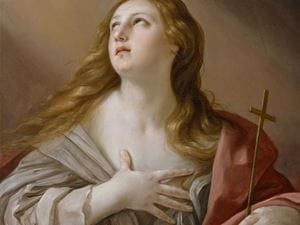
Ask almost any Christian to name the first 10 biblical women they can think of, and six or seven names will probably be on everyone’s list. The list will probably include the Virgin Mary, Eve, Ruth, Delilah, Martha, Esther and, of course, Mary Magdalene. Most people would also be able to tell you at least a one sentence blurb about who each woman was in the Bible. The Virgin Mary, of course, was Jesus’ mother, and Eve was the first woman created in the Garden of Eden. These short descriptors would most likely be more or less the same for each woman. After all, they had a specific role in the Bible. There might be minor changes, such as focusing on Eve’s role in the original sin over her innocent time in the Garden, but for the most part, Christians would all give roughly the same statement to describe each woman. The notable exception, however, is Mary Magdalene.
Who was Mary Magdalene? Most Christians would argue that she was a repentant sinner who came to be a follower of Christ. So, what was her sin? Here, things tend to get fuzzy. Many Christians would say that Mary Magdalene was a prostitute. Others would claim that she was the adulteress in the famous story where Jesus states that the person without sin should throw the first stone. Mary Magdalene has also been identified as the woman who anointed Jesus before His death, and she is most commonly assumed to be some combination of the three. Which of these images of Mary Magdalene, however, is correct?In truth, Mary Magdalene was none of these women. The adulteress Jesus spared in John 8 is never named, neither is the woman who anointed Him before His death. While there was undoubtedly a former prostitute among Jesus’ followers much to the other disciples’ dismay, Mary Magdalene is never identified as one. So, why is the mistaken belief that Mary Magdalene was a repentant prostitute so heavily embedded in Christian culture? Mary Magdalene’s status as a “redeemed whore” actually comes from a mistake made back in the 6th century. In 591, Pope Gregory the Great gave a sermon where he merged three different women in the Bible into one: the sinful woman who purified herself with unguent in Luke, Mary of Bethany in John and Mary Magdalene who was possessed by demons in Mark. As most Christians had no access to a Bible of their own at the time, and would likely have been unable to read it even if they had one, no one realized that the three women Pope Gregory spoke about were different people.
Mary Magdalene’s status as a redeemed prostitute likely stuck not only because there was no alternative portrait or way for the misconception to be easily correct, but also because it was the sort of story that Christians are predisposed to adore. The Bible and all of Christianity place a heavy emphasis on redemption, and stories of redemption are still beloved today. Simply look at the fame of “Les Miserables” which tells the tale of Jean Valjean’s transformation from hardened criminal to savior of children and protector of the downtrodden, the popularity of Severus Snape from “Harry Potter” who spent nearly two decades attempting to repent for his sins as a Death Eater serving Lord Voldemort or even the overarching narrative of the first two “Star Wars” trilogies. Put together, the six movies tell the story of Anakin Skywalker’s fall from grace, transformation into the evil Darth Vader and his eventual redemption and return to the light. Frankly, people also like tales of those who turned their lives around in real life. The idea of a lowly whore transforming her life based on her encounter with Christ was too perfect to give up. To make matters worse for Mary’s reputation, she was commonly portrayed as a sensual creature in both church artwork and the explosion of the arts during the Renaissance. By the time scholars began looking back at the Bible in serious numbers and debating its historical accuracy, it was too late. Mary Magdalene was a former prostitute, and no amount of academic protest would dissuade the wider consensus. People continued to hunt for evidence that she was guilty of some sort of sexual immorality and even used the fact that she was from a town of ill repute as evidence. Some scholars have claimed that Magdala was known for debauchery, but frankly, so is Las Vegas today, and no one with any sense assumes that every woman who lives in Vegas is a streetwalker.
Despite how deeply entrenched the idea of “Mary the Whore” is in Christian culture, she was actually a righteous and wealthy woman. The ancient Greek texts use words that make it clear that she supported the disciples financially often using large amounts of her own money. The imperfect tense used shows that this was not a one-time donation, either. Instead, Mary continually supported the disciples.
Mary was undoubtedly one of the most loyal of the disciples. Not only was she continually supporting them and traveling with them, both things that would have done more than raise eyebrows at the time given that she was a woman, she was also one of the few who stayed with Christ until the end. Mark states that Mary Magdalene watched Jesus’ crucifixion and was at the tomb when Jesus’ body was laid within it. When He rose again, she was, depending on the gospel, either the very first or one of the first witnesses to the Resurrection.
Not every Christian, of course, has ascribed to the belief that Mary Magdalene was a repentant whore. She has been an important and holy figure for centuries, but unfortunately, her overall image is one of a former prostitute. Sadly, many Christians focus on her fictional past as a prostitute and forget that she was one of Christ’s most faithful followers during her life. Ironically, the very religion that fell in love with her redemptive story emphasized her false sins and forgot the faith and holiness that defined her life after she met Christ.

